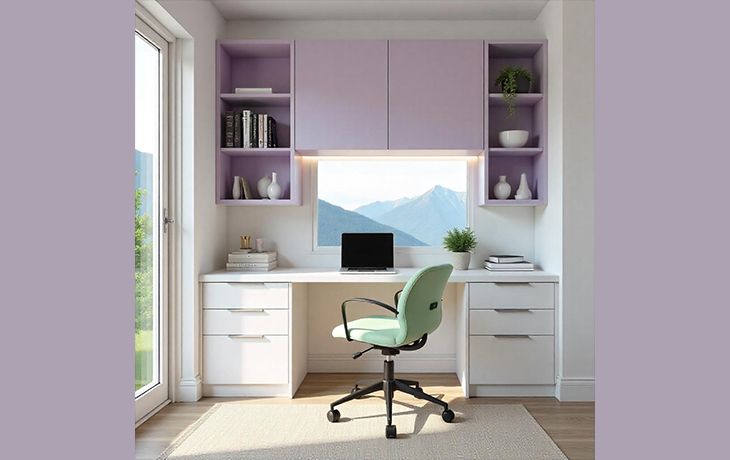
Home Office Ideas: Create a Productive and Inspiring Workspace
With the rise of remote work and hybrid models, having a dedicated and functional home office has become more important than ever. A well-designed workspace can boost productivity, reduce distractions, and keep you motivated throughout the day. This guide will share practical and stylish home office ideas to help you create a space that is both inspiring and efficient.
1. Choose the Right Location
The first step in creating a home office is selecting the perfect spot.
Things to Consider:
• Quietness: Choose a room or corner away from household noise and distractions.
• Lighting: Pick a space with plenty of natural light to improve focus and reduce eye strain.
• Privacy: If you share your home, a secluded area or room with a door works best.
Pro Tip: If space is limited, consider converting a closet, hallway nook, or underutilized corner into your workspace.
2. Invest in Ergonomic Furniture
Comfort is key when working for long hours, so prioritize ergonomic furniture.
Must-Have Furniture:
• Ergonomic Chair: Look for adjustable height, lumbar support, and a cushioned seat.
• Desk: Choose a desk with sufficient space for your computer, paperwork, and other essentials.
• Standing Desk: If you want to mix things up, opt for a height-adjustable standing desk.
Pro Tip: Use a footrest, wrist support, or monitor stand to ensure proper posture and comfort.
• Offers a clean and seamless look. • Great for maximizing space.
3. Optimize Lighting
Good lighting is essential for a productive workspace.
Lighting Ideas:
• Natural Light: Position your desk near a window to make the most of natural daylight.
• Task Lighting: Use a desk lamp with adjustable brightness for focused light on your work area.
• Ambient Lighting: Add soft overhead lighting to brighten the entire space.
Pro Tip: Use warm white LED bulbs to reduce glare and create a cozy atmosphere.
4. Keep the Desk Clutter-Free
An organized workspace boosts focus and minimizes distractions.
Desk Organization Tips:
• Use desk organizers for stationery, files, and other essentials.
• Install cable management solutions like clips or sleeves to keep wires tidy.
• Opt for a minimalist desk setup with only the essentials—laptop, notepad, and a pen holder.
Pro Tip: At the end of each day, spend 5 minutes decluttering your desk to start fresh the next morning.
5. Add Smart Storage Solutions
Efficient storage is crucial to maintaining a clean and functional workspace.
Smart Storage Ideas:
• Floating Shelves: Use vertical wall space to store books, decor, or office supplies.
• Filing Cabinets: Keep important documents organized and within reach.
• Storage Boxes: Use stackable boxes or baskets for small items like cables and chargers.
• Multi-Functional Furniture: Choose desks or benches with built-in storage.
Pro Tip: Label storage bins and files for quick and easy access to items.
6. Personalize Your Space
Adding personal touches can make your home office more inviting and motivating.
Personalization Ideas:
• Art and Decor: Hang artwork, motivational quotes, or personal photos to make the space inspiring.
• Plants: Incorporate greenery with low-maintenance indoor plants like succulents or peace lilies.
• Rugs and Curtains: Use stylish rugs and curtains to add texture and warmth to the room.
Pro Tip: Keep personalization subtle to avoid overwhelming the workspace.
7. Incorporate Technology
Tech solutions can enhance productivity and streamline your work-from-home experience.
Essential Tech Gadgets:
• High-Speed Internet: Ensure your workspace has a strong Wi-Fi connection.
• Noise-Cancelling Headphones: Block out background noise for better focus during calls.
• Monitor Setup: Use dual screens or a larger monitor for multitasking.
• Wireless Keyboard and Mouse: Minimize cable clutter and improve mobility.
8. Budget Planning
Set a budget before starting your wardrobe project. Consider:
• The cost of materials and finishes.
• Installation charges.
• Customizations or add-ons like lighting or accessories.
Pro Tip: Invest in a surge protector to safeguard your devices from power fluctuations.
8. Create a Productive Layout
Layout Tips:
• Follow the “Triangle Rule” by placing your desk, chair, and storage within easy reach.
• Position your monitor at eye level to reduce neck strain.
• Leave enough space for movement and a small seating area for visitors, if possible.
Pro Tip: Test different layouts to find the most ergonomic and efficient setup for your needs.
9. Designate Zones for Different Activities
If you have enough space, create distinct zones for various work activities.
Zones to Consider:
• Main Work Area: Desk with a computer and essential supplies.
• Brainstorming Zone: A whiteboard or corkboard for jotting down ideas and tasks.
• Relaxation Zone: A comfortable chair or beanbag for breaks and reading.
10. Add Noise Reduction Features
A quiet workspace is crucial for concentration and productivity.
Noise Reduction Ideas:
• Soundproof Curtains: Block outside noise from windows.
• Rugs and Carpets: Absorb sound and minimize echo in the room.
• Acoustic Panels: Install foam panels on walls for better sound insulation.
• White Noise Machine: Use a white noise machine to mask background distractions.
Pro Tip: Noise-canceling headphones are an excellent alternative if soundproofing isn’t feasible.




